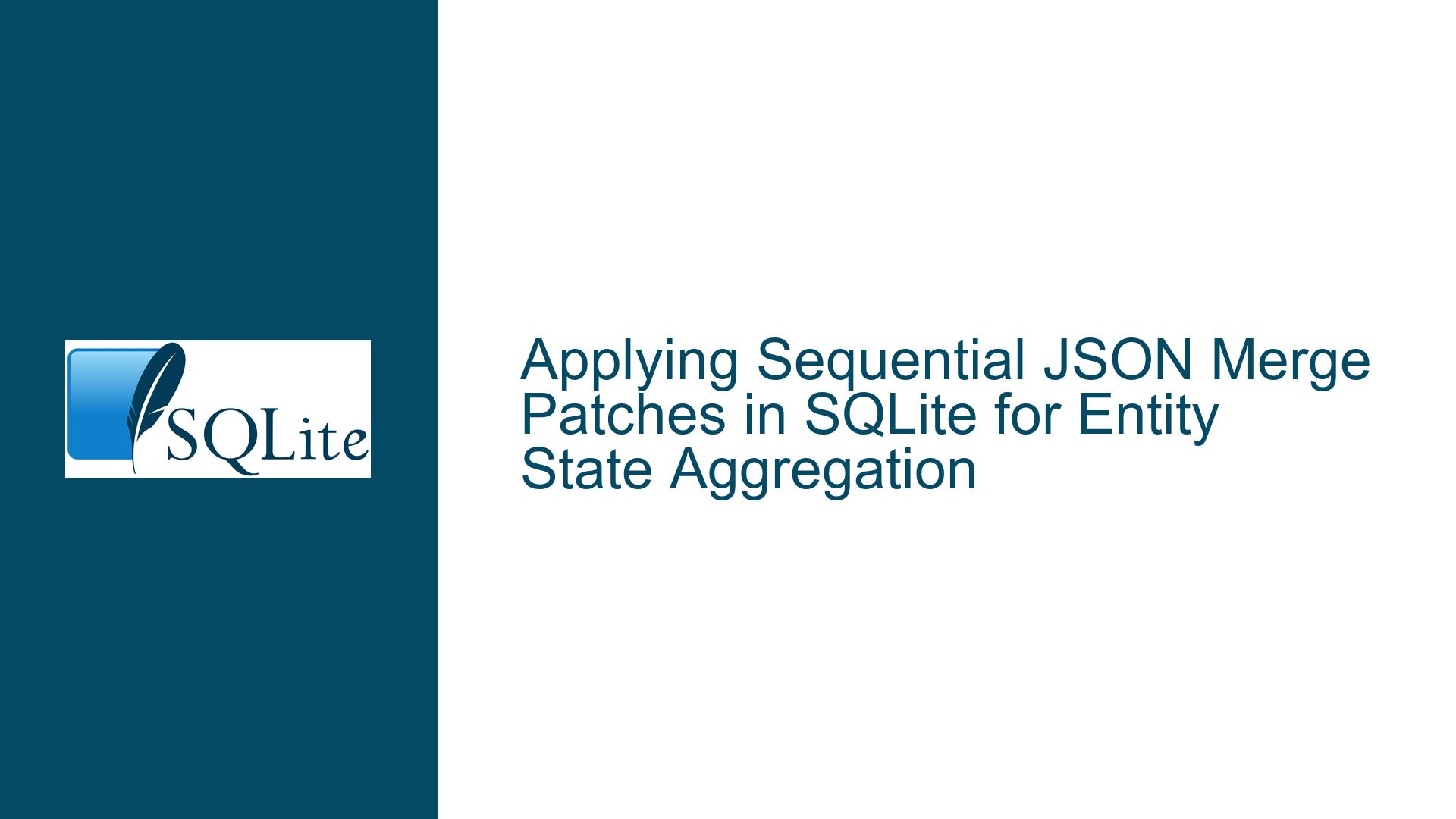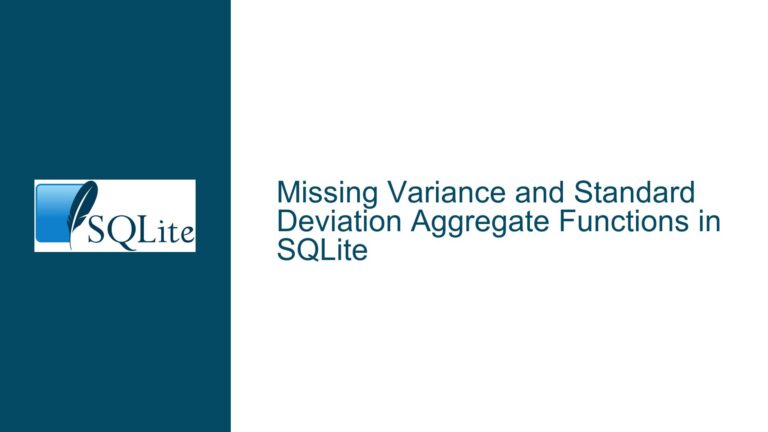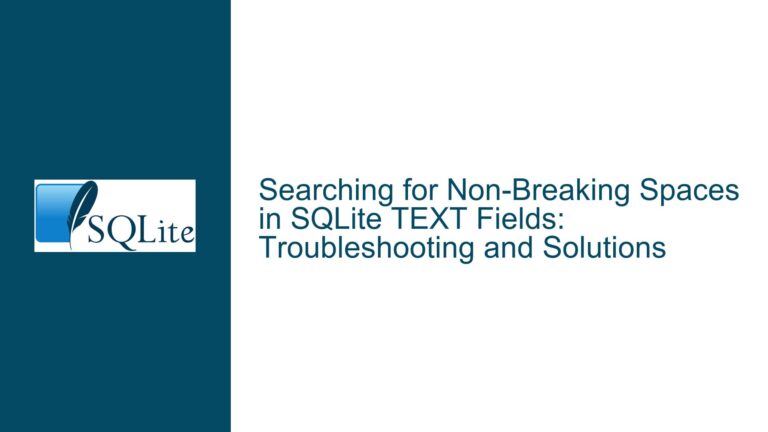Applying Sequential JSON Merge Patches in SQLite for Entity State Aggregation
Issue Overview: Challenges in Aggregating Sequential JSON Merge Patches for Entity State
The core challenge revolves around consolidating multiple JSON Merge Patch operations stored as sequential events for a specific entity into a final merged state. The events table contains historical patches applied to an entity’s state over time, with each patch modifying specific fields (e.g., position, velocity). The objective is to produce a single JSON object representing the cumulative effect of all patches applied in chronological order.
SQLite’s JSON1 extension provides json_patch(), which applies RFC 7396 merge semantics. However, applying this function across multiple rows requires a mechanism to iteratively merge patches while preserving order. The initial approach considered recursion via Common Table Expressions (CTEs) faced hurdles due to the inability to collapse intermediate results into a single value using standard UNION ALL operations. This arises because recursive CTEs in SQLite are designed to accumulate rows rather than progressively transform a single value across iterations.
Key complexities include:
- Temporal Order Dependency: Patches must be applied in strict timestamp order to ensure later modifications override earlier ones correctly.
- Hierarchical JSON Merging: Nested structures (e.g.,
position.altitude,velocity.x) require deep merging rather than shallow field replacement. - Efficient Row Processing: Handling potentially large datasets without excessive memory consumption or recursion depth limits.
Possible Causes: Misalignment Between Recursive CTE Mechanics and JSON Merge Requirements
Three primary factors contribute to the difficulty in achieving the desired aggregation:
Row-Based Recursion vs. Value Accumulation
Recursive CTEs in SQLite operate on rows, not scalar values. When usingUNION ALL, each iteration appends new rows to the result set rather than modifying an existing value. This conflicts with the need to maintain a single evolving JSON state across iterations. Attempts to useUNION ALLwithout a value aggregation strategy result in multiple independent rows instead of a progressively merged JSON object.Lack of Ordered Window Functions in Recursive Contexts
While window functions likeROW_NUMBER()can order patches chronologically outside recursion, incorporating this ordering into the recursive CTE’s traversal logic is non-trivial. The recursive member of a CTE cannot directly reference window functions applied in the non-recursive member, complicating ordered traversal.JSON Merge Semantics and Function Limitations
Thejson_patch()function merges two JSON objects but doesn’t natively support merging across a series of objects in a table. Without a mechanism to chainjson_patch()calls across rows, each merge operation exists in isolation, preventing cumulative state propagation.
Troubleshooting Steps, Solutions & Fixes: Implementing Ordered Recursive Merging with JSON1
Step 1: Establish Chronological Ordering of Patches
Before merging, ensure patches are processed in strict timestamp order. Use a WITH clause to materialize an ordered view of events:
WITH OrderedEvents AS (
SELECT
entity_id,
patch,
timestamp
FROM events
WHERE entity_id = 5619707354218640809 -- Target entity
ORDER BY timestamp
)
Step 2: Recursive CTE with State Accumulation
Leverage a recursive CTE to iteratively apply json_patch(), carrying forward the merged state:
RECURSIVE MergeSequence AS (
-- Anchor member: Initial patch
SELECT
1 AS iteration,
entity_id,
patch AS merged_patch,
timestamp
FROM OrderedEvents
LIMIT 1
UNION ALL
-- Recursive member: Apply next patch
SELECT
MergeSequence.iteration + 1,
MergeSequence.entity_id,
json_patch(
MergeSequence.merged_patch,
OrderedEvents.patch
) AS merged_patch,
OrderedEvents.timestamp
FROM MergeSequence
JOIN OrderedEvents
ON MergeSequence.iteration + 1 = OrderedEvents.rowid
)
Explanation:
- The anchor member initializes the merge process with the first patch.
- The recursive member joins the current merged state (
MergeSequence) with the next ordered patch (OrderedEvents) usingiterationas a counter. json_patch()merges the accumulated state with the next patch in sequence.
Step 3: Extract Final Merged State
After building the merge sequence, select the latest iteration’s result:
SELECT
merged_patch
FROM MergeSequence
ORDER BY iteration DESC
LIMIT 1;
Optimization Notes:
- Indexing: Ensure
events.timestampandevents.entity_idare indexed to accelerate ordering. - Recursion Depth: SQLite’s default recursion depth limit (
SQLITE_MAX_RECURSION, typically 1000) is sufficient for most event streams. Adjust usingPRAGMA max_recursion_depthif necessary. - Partial Merging: For incremental updates, store intermediate merged states in a temporary table.
Alternative Approach: Window Function Aggregation
For SQLite versions with window function support (3.25+), json_group_array() can serialize patches into an ordered JSON array, followed by a custom aggregation function:
WITH PatchesArray AS (
SELECT
json_group_array(patch) OVER (
ORDER BY timestamp
ROWS BETWEEN UNBOUNDED PRECEDING AND UNBOUNDED FOLLOWING
) AS patch_array
FROM events
WHERE entity_id = 5619707354218640809
)
SELECT json_patch_accumulate(patch_array) FROM PatchesArray;
Note: json_patch_accumulate() is a hypothetical user-defined function (UDF) that iterates over the array. Implementing this requires SQLite C extensions or application-side processing.
Debugging Common Issues
- Incorrect Merge Order: Verify timestamp ordering in
OrderedEventsusing standalone queries. - Null Fields in Output:
json_patch()removes fields set tonull. Ensure patches intentionally nullify fields rather than suffering from syntax errors. - Type Mismatches: JSON type inconsistencies (e.g., string vs. number) between patches can cause silent failures. Validate patch structures with
json_valid().
By systematically applying ordered recursive merging with json_patch(), the cumulative state of an entity can be accurately reconstructed from its event history. This approach balances correctness with efficiency, leveraging SQLite’s native JSON capabilities while respecting temporal dependencies.






